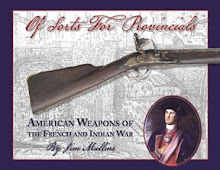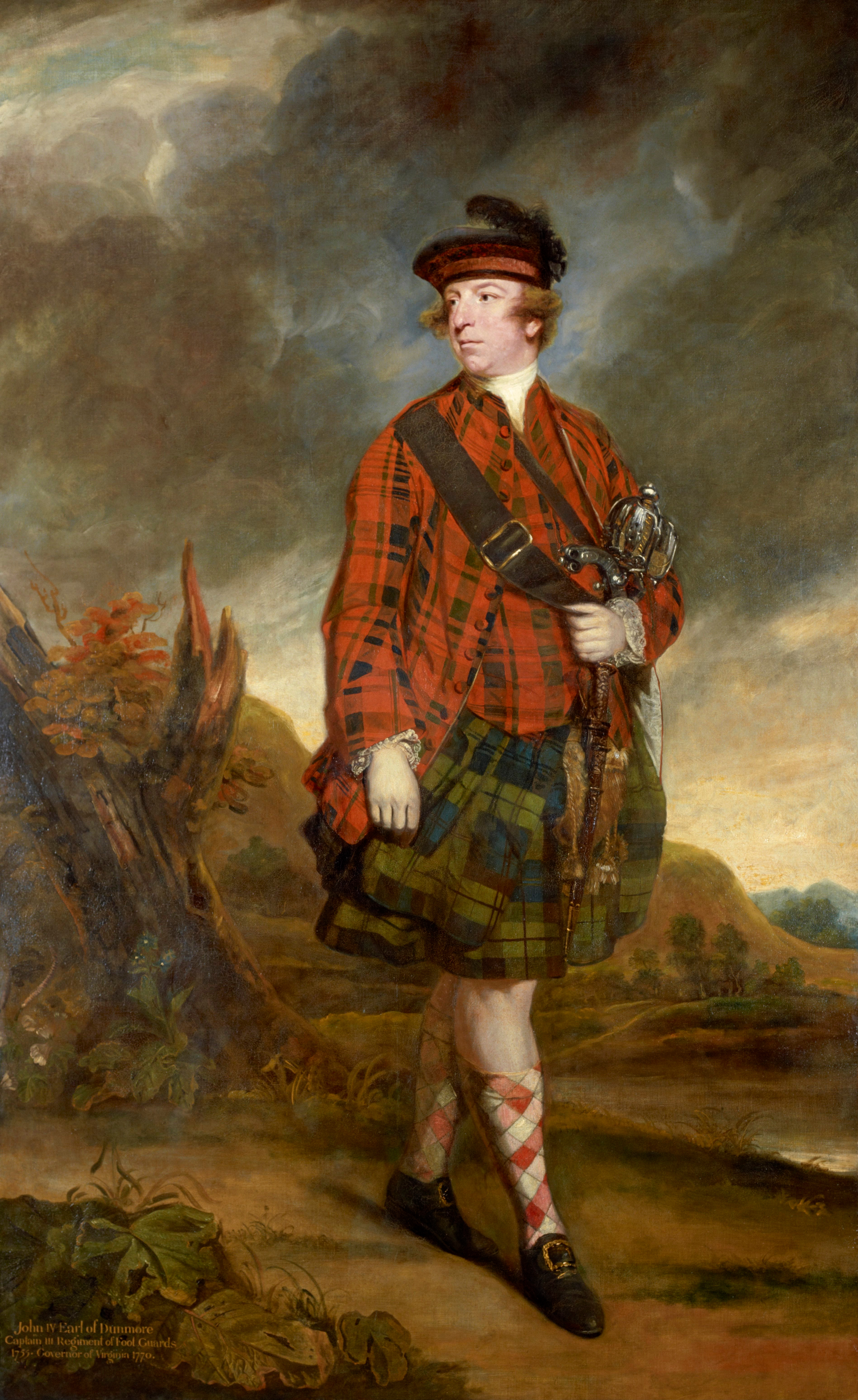An in depth discussion of the causes and politics behind the campaign are a bit involved for a blog post, but I highly recommend the recent scholarship on this campaign by Glenn F. Williams, author of Dunmore's War: The Last Conflict of America's Colonial Era. Additionally the Documentary History of Dunmore's War has a large amount of primary source information.
The Virginia militia was embodied in two wings, Andrew Lewis commanding the men who fought at Point Pleasant and Dunmore personally commanded the Northern Wing which was in the field but not present at the battle.
Generally speaking, Virginia militia was not uniformed, and wore their civilian clothes for service (typically a coat, waistcoat and breeches). Hunting shirts of various colors were favored by the "Back Wood's Rifleman" as described by John Ferdinand Smyth Stuart:
"Their hunting, or rifle shirts, they have also died in a variety of colours, some yellow, others red, some brown, and many wear them quite white...Sometimes they wear leather breeches, made of Indian dressed elk, or deer skins, but more frequently thin trowsers. On their legs they have Indian boots, or leggings made of coarse woolen cloth...”
However, some companies received issued osnabrigs (unbleached natural colored linen) hunting shirts and blue wool leggings for the expedition and would have been fairly uniform in appearance.
August 28th, 1774
"Dr. Colo. I have got as fare as Mr. Branders with a handful of Men out of my own Company. I think our Number of private Men is thirty one....the Men I have, are fit for the business, but are badly fix'd, for want of Hunting shirts, and Blankets; but as I hear Mr. Branders Waggon,is on this side New River; I hope we shall get supply'd...I shall be glad Sir., if it can be done, to have a Gun provided against we come down, as I have a very good Hand without: when I was in the service before, there was near twenty press'd Guns: which the Country freely pay'd for, and I doubt not, but the same necessity will be allowed now..."
Both hunting and body shirts were procured at McCorkle's store in what is now Pulaski county Virginia by officers commanding companies on the expedition. Individual soldiers purchased cuttoe knives, printed hankerchiefs and wool cloth.
[Col. William Christian to Col. William Preston. 3QQ89] Head Of Rich Creek, Septr. 3: 1774
"I am informed that Men & provisions were moving from Stanton Wednesday and thursday was a week and that several Compys were at the Warm Springs. It is also said Mathews dont propose taking out all the flour at once, but to send back the pack horses from the mouth of Elk. That LA. Dunmore wrote to Ch. Lewis that some of his men had taken some little Towns & killed three or [four] people & that his Lordship was at fort Pitt. The above news came by one of the Woods's. He says also that there is Jents plenty and all goods necessary for the men such as Shirts Blankets Leggons."
In addition, the "Northern" Wing serving directly under Dunmore may have used cockades. "My Brother Jams went with Dumore as a Lieutenant. He raised some of his men in our county. They had Cockades of red ribond. I admired the looks of these soldiers so much I would have been glad to have went with them if I had been old enough." (Westward Into Kentucky: The Narrative of Daniel Trabue p42). Immediately after the battle Dunmore was described as "dressed in a Dutch blanket" which may refer to him using a blanket as a matchcoat or perhaps as a blanket coat.
Although the Militia law had expired, the general framework seems to have been followed.
That every person so as aforesaid inlisted (except free mulattoes, negroes, and Indians) shall be armed in the manner following, that is to say: Every soldier shall be furnished with a firelock well fixed, a bayonet fitted to same, a double cartouch-box and three charges of powder, and constantly appear with the same at the time and place appointed for muster and exercise, and shall also keep at his place of abode one pound of powder and four pounds of ball, and bring the same with him into the field when he shall be required.
Archeological evidence and primary source documents point to the many of the muskets in use during this period as King's Pattern Long Land "Brown Bess" style or Dutch muskets, both of which were imported in sizeable numbers during the French and Indian war. Primary document use of the generic term "gun" suggests the very common fowling piece or shotgun was in the mix, and many of the men under Lewis seem to have been armed with rifled guns.
As noted, in Glenn Williams' detailed scholarship, the Northern wing's arms were augmented by 300 muskets with bayonets and cartouche boxes from Williamsburg. Further confirmation of this comes from the Journal of the house of Burgesses v6 p223 June 13 1775:
"It appears to your Committee from the Deposition of John Frederick Miller, keeper of the Magazine, that in June last [1774] there were thirty barrels of Gun Powder, containing each about fifty weight, in indifferent order; that, by the Governor's directions, he sifted twenty seven barrels, out of which he made up twenty six Casks and better, the other three he left unsifted; That the President, soon after, sent to the Governor, then on the Frontiers, eight of those he had sifted, three hundred Muskets,
Bayonets, Cartouch boxes and Carbines, which have never been returned; That one hundred and sixty of the said Muskets were furnished out of the Palace, and soon after replaced out of the Magazine; That the said Miller, by order of the President, also delivered out about fifty stand of Arms, to some Gentlemen of this City, which have not been returned."
The troops under Lewis were described by William Preston as "being mostly armed with rifle guns, and a great part of them good woodsmen, are looked upon to be at least equal to any troops for the number that have been raised in America. It is earnestly hoped that they will, in conjunction with the other party, be able to chastise the Ohio Indians for the many murders and robberies they have committed on our frontiers for many years past."
Ammunition was in short supply, and Maj. Arthur Campbell wrote to Col. William Preston that "..I make no doubt but your last supply of Ammunition will encourage the Inhabitants much, as I think every Man have 1/2 doz shoots a piece having direct[ed] the Powder to be divided by their Gun-Measures."
[Captain John Floyd to Col. William Preston. 33S42, 43.]
Sept. 18th 1774...
I am in hopes we shall make out pretty well about kettles we are also allowed 60 yards of tent cloth for a company...” p. 206-07.
[Col. William Christian to Col. William Preston. 3QQ146.]
“Camp Union Septr. 12, 1774...
The kettles and Tents were chiefly distributed before I came I could get but 16 or 17 battered tin kettles for all Fincastle & but few Tents But I am told oxen brigs [unknown symbol or doodle here] enough for Tents will be brought with the Pack horses to morrow If the major is not marched
when you get this Intelligence I really think we ough[t] to send over the whole Country and try to beg or borrow kettles for to do withougt[sic] is very hard almost [im?]possible
It will presently make men sick to live on Roasted meat without broath.” p. 198.








